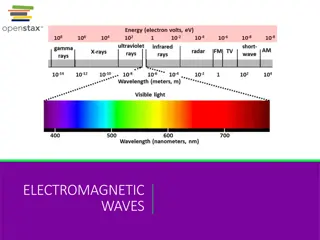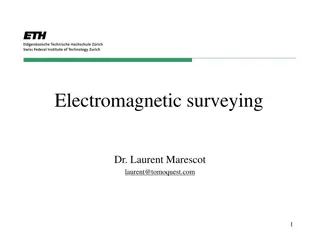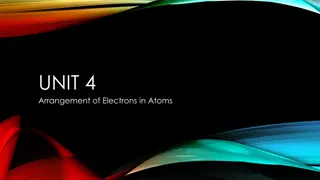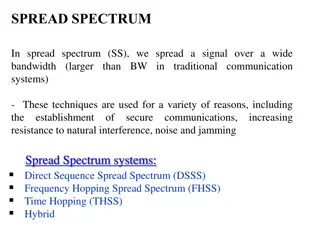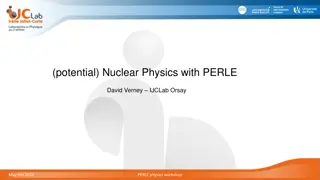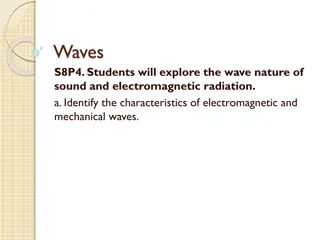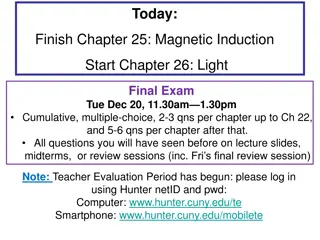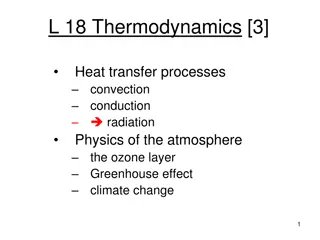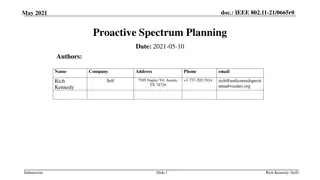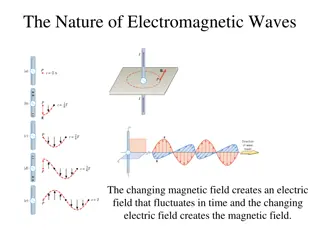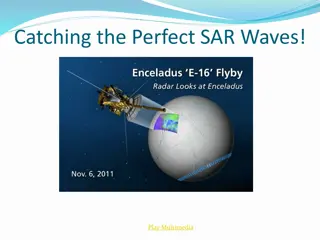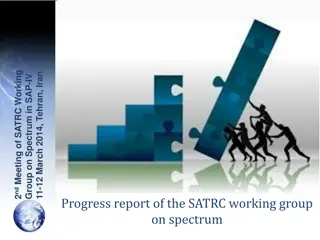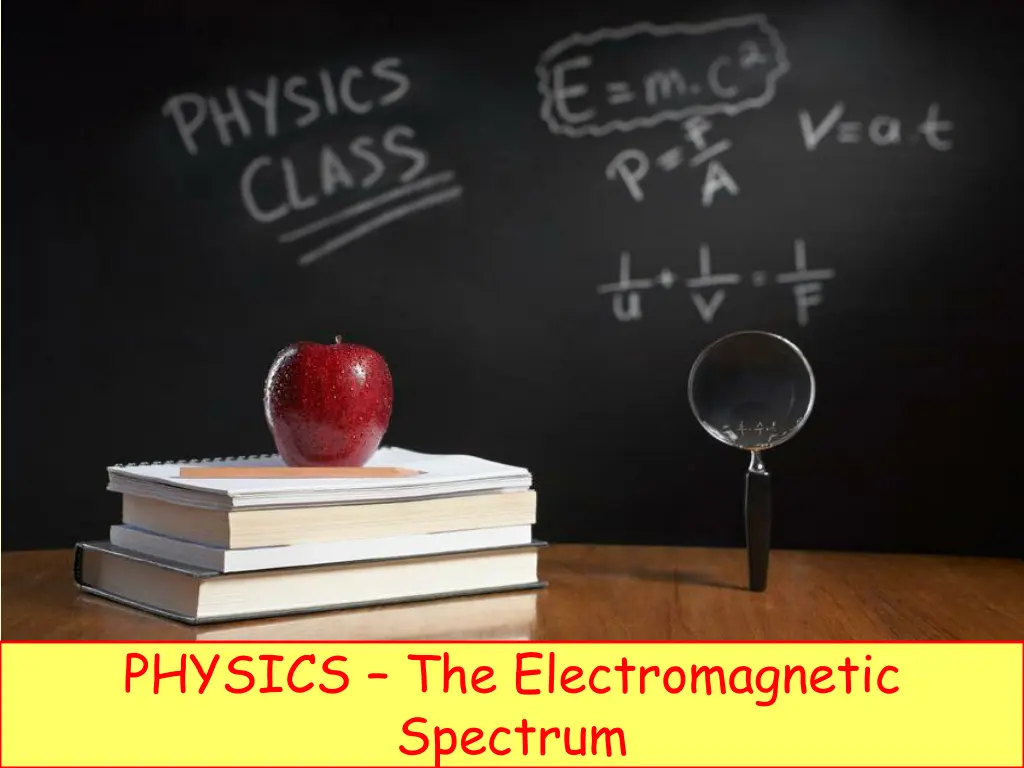
Understanding the Electromagnetic Spectrum and Light Dispersion Phenomenon
Explore the intriguing world of the electromagnetic spectrum and the dispersion of white light through a glass prism. Learn about the seven colors of the spectrum, wavelength variations, and the properties and applications of different electromagnetic radiations. Understand the concept of monochromatic light and its significance. Discover how lasers emit light of a single color and wavelength, known as monochromatic light.
Uploaded on | 1 Views
Download Presentation

Please find below an Image/Link to download the presentation.
The content on the website is provided AS IS for your information and personal use only. It may not be sold, licensed, or shared on other websites without obtaining consent from the author. If you encounter any issues during the download, it is possible that the publisher has removed the file from their server.
You are allowed to download the files provided on this website for personal or commercial use, subject to the condition that they are used lawfully. All files are the property of their respective owners.
The content on the website is provided AS IS for your information and personal use only. It may not be sold, licensed, or shared on other websites without obtaining consent from the author.
E N D
Presentation Transcript
PHYSICS The Electromagnetic Spectrum
LEARNING OBJECTIVES Core Give a qualitative account of the dispersion of light as shown by the action on light of a glass prism including the seven colours of the spectrum in their correct order Describe the main features of the electromagnetic spectrum in order of wavelength State that all e.m. waves travel with the same high speed in a vacuum Describe typical properties and uses of radiations in all the different regions of the electromagnetic spectrum including: r adio and television communications (radio waves) s atellite television and telephones (microwaves) e lectrical appliances, remote controllers for televisions and intruder alarms (infra-red) medicine and security (X-rays) Demonstrate an awareness of safety issues regarding the use of microwaves and X-rays Supplement Recall that light of a single frequency is described as monochromatic State that the speed of electromagnetic waves in a vacuum is 3.0 108 m / s and is approximately the same in air
Refraction of light by a prism. White light
Refraction of light by a prism. Refraction
Refraction of light by a prism.
Refraction of light by a prism. This effect is called dispersion
Refraction of light by a prism. This effect is called dispersion
Refraction of light by a prism. This effect is called dispersion It happens because white is a mixture of all the colours in the rainbow
Wavelength and colour White light is made up of different colours with wavelengths ranging from 0.0004mm (violet) to 0.0007mm (red).
Wavelength and colour White light is made up of different colours with wavelengths ranging from 0.0004mm (violet) to 0.0007mm (red). Lasers, however, only emit light of a single colour and wavelength. This type of light is known as monochromatic light.
LEARNING OBJECTIVES Core Give a qualitative account of the dispersion of light as shown by the action on light of a glass prism including the seven colours of the spectrum in their correct order Describe the main features of the electromagnetic spectrum in order of wavelength State that all e.m. waves travel with the same high speed in a vacuum Describe typical properties and uses of radiations in all the different regions of the electromagnetic spectrum including: r adio and television communications (radio waves) s atellite television and telephones (microwaves) e lectrical appliances, remote controllers for televisions and intruder alarms (infra-red) medicine and security (X-rays) Demonstrate an awareness of safety issues regarding the use of microwaves and X-rays Supplement Recall that light of a single frequency is described as monochromatic State that the speed of electromagnetic waves in a vacuum is 3.0 108 m / s and is approximately the same in air
The Electromagnetic Spectrum 1. They can travel through a vacuum (eg. Space) Features of the electromagnetic spectrum
The Electromagnetic Spectrum 1. They can travel through a vacuum (eg. Space) 2. In a vacuum they travel at a speed of 300 000 kilometres per second. Features of the electromagnetic spectrum
The Electromagnetic Spectrum 1. They can travel through a vacuum (eg. Space) 2. In a vacuum they travel at a speed of 300 000 kilometres per second. 3. They are all transverse waves, with oscillations at right angles to the direction of travel. Features of the electromagnetic spectrum
The Electromagnetic Spectrum 1. They can travel through a vacuum (eg. Space) 2. In a vacuum they travel at a speed of 300 000 kilometres per second. 3. They are all transverse waves, with oscillations at right angles to the direction of travel. 4. Electromagnetic waves transfer energy. Features of the electromagnetic spectrum
The Electromagnetic Spectrum Wavelength (m) 104 10-1 10-14 10-3 10-7 10-11 10-6 10-9
The Electromagnetic Spectrum Frequency (Hz) 105 1010 1022 1012 1015 1019 1014 1017
Wavelengths decrease going along the EM spectrum from radio waves to gamma rays. Frequencies increase going along the EM spectrum from radio waves to gamma rays.
Wavelengths decrease going along the EM spectrum from radio waves to gamma rays. Frequencies increase going along the EM spectrum from radio waves to gamma rays. Radio wave photons have the lowest frequency and the least energy, and gamma ray photons have the highest frequency and the most energy.
The Electromagnetic Spectrum Intensity and distance Whenever radiation is absorbed by matter, photons transfer their energy to the matter.
The Electromagnetic Spectrum Intensity and distance The energy deposited by a beam of electrons depends upon the number of photons and the energy of each photon. Whenever radiation is absorbed by matter, photons transfer their energy to the matter.
The Electromagnetic Spectrum Intensity and distance The energy deposited by a beam of electrons depends upon the number of photons and the energy of each photon. Whenever radiation is absorbed by matter, photons transfer their energy to the matter. The intensity of radiation means how much energy arrives at each square metre of surface per second (W/m2).
The Electromagnetic Spectrum Intensity and distance The energy deposited by a beam of electrons depends upon the number of photons and the energy of each photon. Whenever radiation is absorbed by matter, photons transfer their energy to the matter. The intensity of radiation means how much energy arrives at each square metre of surface per second (W/m2). The intensity of a beam of radiation decreases with distance from the source.
1. The beam gets spread out 2. The beam gets partially absorbed as it travels. The Electromagnetic Spectrum Intensity and distance The energy deposited by a beam of electrons depends upon the number of photons and the energy of each photon. Whenever radiation is absorbed by matter, photons transfer their energy to the matter. The intensity of radiation means how much energy arrives at each square metre of surface per second (W/m2). The intensity of a beam of radiation decreases with distance from the source.
The Electromagnetic Spectrum . and ionisation
The Electromagnetic Spectrum Some high energy EM radiation (ultraviolet, X-rays and gamma rays) are known as ionising radiation because they have enough energy to remove an electron from an atom or molecule) . and ionisation
The Electromagnetic Spectrum Some high energy EM radiation (ultraviolet, X-rays and gamma rays) are known as ionising radiation because they have enough energy to remove an electron from an atom or molecule) . and ionisation Before ionisation photon Atom or molecule
The Electromagnetic Spectrum Some high energy EM radiation (ultraviolet, X-rays and gamma rays) are known as ionising radiation because they have enough energy to remove an electron from an atom or molecule) . and ionisation Before ionisation After ionisation electron photon Changed atom or molecule Atom or molecule The photon hits the atom or molecule, and removes an electron.
The Electromagnetic Spectrum Some high energy EM radiation (ultraviolet, X-rays and gamma rays) are known as ionising radiation because they have enough energy to remove an electron from an atom or molecule) . and ionisation Before ionisation After ionisation If cells are exposed to ionising radiation, they can damage the DNA in the nucleus of the cell. This can cause mutations, and the cells divide constantly without control this is cancer. Very high doses of ionising radiation can kill cells. Excessive exposure to UV radiation can lead to sunburn or even skin cancer. Increased exposure = more damage electron photon Changed atom or molecule Atom or molecule The photon hits the atom or molecule, and removes an electron.
The Electromagnetic Spectrum . and dangers
The Electromagnetic Spectrum . and dangers X - rays X-rays are used by radiographers in hospitals to check for broken bones. X-rays pass easily through flesh, but are absorbed by denser materials like bone and metal. X-ray imaging is also used in airports to check the contents of bags. Precautions: radiograhers wear lead aprons or stand behind concrete to protect themselves.
The Electromagnetic Spectrum . and dangers Microwaves X - rays X-rays are used by radiographers in hospitals to check for broken bones. X-rays pass easily through flesh, but are absorbed by denser materials like bone and metal. X-ray imaging is also used in airports to check the contents of bags. Microwaves are used to send signals between mobile phones and mobile phone masts. When you make calls on your mobile, your phone emits microwave radiation. Some of this is absorbed by your body and may cause heating of body tissues. This heating could result in medical conditions, possibly including cancer, but there is no conclusive evidence. Precautions: radiograhers wear lead aprons or stand behind concrete to protect themselves. Precaution: limit the amount of time you spend talking on a mobile phone!
The Electromagnetic Spectrum Uses Broadcasting Communications, Satellite transmissions
The Electromagnetic Spectrum Uses Cooking, Communications, Satellite transmissions Broadcasting Communications, Satellite transmissions
The Electromagnetic Spectrum Uses Cooking, thermal imaging, short range communications, optical fibres, TV remote controls, security systems. Cooking, Communications, Satellite transmissions Broadcasting Communications, Satellite transmissions
The Electromagnetic Spectrum Uses Cooking, thermal imaging, short range communications, optical fibres, TV remote controls, security systems. Cooking, Communications, Satellite transmissions Broadcasting Communications, Satellite transmissions Vision Photography Illumination
The Electromagnetic Spectrum Uses Cooking, thermal imaging, short range communications, optical fibres, TV remote controls, security systems. Security marking, Cooking, Communications, Satellite transmissions Broadcasting Communications, Satellite transmissions Vision Fluorescent lamps, Detecting forged bank notes, Disinfecting water Photography Illumination
The Electromagnetic Spectrum Uses Observing the internal structure of objects, Airport security scanners, Medical X-rays Cooking, thermal imaging, short range communications, optical fibres, TV remote controls, security systems. Security marking, Cooking, Communications, Satellite transmissions Broadcasting Communications, Satellite transmissions Vision Fluorescent lamps, Detecting forged bank notes, Disinfecting water Photography Illumination
The Electromagnetic Spectrum Uses Observing the internal structure of objects, Airport security scanners, Medical X-rays Sterilising food and medical equipment, Detection of cancer and its treatment. Cooking, thermal imaging, short range communications, optical fibres, TV remote controls, security systems. Security marking, Cooking, Communications, Satellite transmissions Broadcasting Communications, Satellite transmissions Vision Fluorescent lamps, Detecting forged bank notes, Disinfecting water Photography Illumination
LEARNING OBJECTIVES Core Give a qualitative account of the dispersion of light as shown by the action on light of a glass prism including the seven colours of the spectrum in their correct order Describe the main features of the electromagnetic spectrum in order of wavelength State that all e.m. waves travel with the same high speed in a vacuum Describe typical properties and uses of radiations in all the different regions of the electromagnetic spectrum including: r adio and television communications (radio waves) s atellite television and telephones (microwaves) e lectrical appliances, remote controllers for televisions and intruder alarms (infra-red) medicine and security (X-rays) Demonstrate an awareness of safety issues regarding the use of microwaves and X-rays Supplement Recall that light of a single frequency is described as monochromatic State that the speed of electromagnetic waves in a vacuum is 3.0 108 m / s and is approximately the same in air
PHYSICS The Electromagnetic Spectrum

